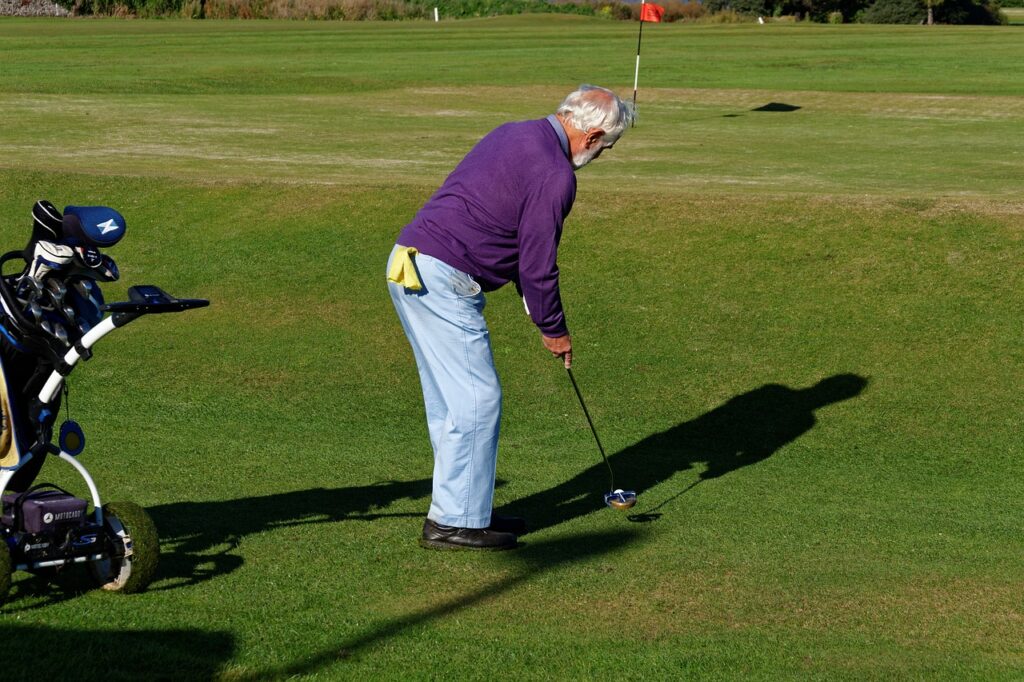How is Par Determined in Golf?
Golf is a sport that challenges players to hit a small ball into a hole using different clubs. The goal is to complete each hole in as few strokes as possible. But how do we measure the difficulty of each hole and compare the performance of different golfers? This is where the concept of par comes in.
To understand how well a golfer performs on a specific hole or course, the concept of par comes into play. Par is a standard score that represents the expected number of strokes it should take an average golfer to complete a hole or an entire round.
In this article, we will delve into the details of how par is determined in golf, exploring the factors that influence this score and shedding light on the nuances of golf scoring.
What is Par?

Par is the predetermined or expected number of strokes that an expert or proficient golfer should require to complete a hole, a round, or a tournament in golf Par is the standard to which golfers aspire and the baseline for comparing scores.
Par is usually related to the length and difficulty of each hole and can vary from par 3 to par 5 Par is also a term that was once used interchangeably with bogey, which is now a score of one over par
For scoring purposes, a golfer’s number of strokes is compared with the par score to determine how much the golfer was either “over par”, “under par”, or was “even with/equal to par” For example, if a hole has a par of 4 and a golfer takes 5 strokes to complete it, the reported score is +1, or “one-over-par”. If a golfer takes 3 strokes, the reported score is −1, or “one-under-par”.
How is Par Determined?
Par is primarily determined by the playing length of each hole from the teeing ground to the putting green.
Holes are generally assigned par values between three and five, which include a regulation number of strokes to reach the green based on the average distance a proficient golfer hits the ball, and two putts.
On occasion, factors other than distance are taken into account when setting the par for a hole; these include altitude, terrain, and obstacles that result in a hole playing longer or shorter than its measured distance, e.g. route is significantly uphill or downhill, or requiring play of a stroke to finish short of a body of water before hitting over it
In general, par-3 holes for men will be under 260 yards (240 m) from the tee to the green, par-4 holes will be 240–490 yards (220–450 m), par-5 holes will be 450–710 yards (410–650 m) and par-6 holes will be over 670 yards (610 m).
For women, par-3 holes will be under 220 yards (200 m) from the tee to the green, par-4 holes will be 200–420 yards (180–380 m), par-5 holes will be 370–600 yards (340–550 m) and par-6 holes will be over 570 yards (520 m).
These boundaries are commonly extended or shortened for elite or non-elite tournament players, who will often encounter par-4 holes of 500 yards (460 m) or more; this is often the result of a normal par-5 hole being rated as a par-4 for them Some golf courses feature par-7 holes, but these are not recognized by the United States Golf Association
Factors Influencing Par
Several factors influence the determination of par on a golf course. These factors include the hole’s length, the layout of hazards and obstacles, the terrain, and the skill level of the target audience. Golf course architects carefully assess these factors to create a challenging yet fair playing experience for golfers of varying skill levels.
Calculating Par: Yardage and Difficulty
The calculation of partakes into account the yardage of a hole and its difficulty. The distance from the tee to the hole contributes to the determination of par.
Generally, shorter holes require fewer strokes and are designated as par 3, while longer holes necessitate more strokes and are classified as par 4 or par 5. The difficulty of a hole is influenced by factors such as the presence of bunkers, water hazards, rough terrain, and the shape of the green.
The Role of Course Rating and Slope Rating
To accurately determine par, golf courses undergo a rating process that assesses their difficulty level. Course rating is a measure of the playing difficulty for a scratch golfer, while slope rating evaluates the relative difficulty of the course for a bogey golfer.
These ratings are used in conjunction with the yardage to establish the appropriate par for each hole.
Adjustments for Handicap and Course Handicap
Handicap is a numerical value assigned to a golfer based on their skill level. It allows players of differing abilities to compete on an equal footing. When calculating par for a golfer with a handicap, adjustments are made to the designated par of each hole.
These adjustments, known as the Course Handicap, ensure a fair scoring system that considers individual players’ capabilities.
Par Breakdown: Hole Types and Yardage Ranges

Golf courses consist of a variety of holes, each with its own unique characteristics. Let’s explore the breakdown of par and yardage ranges for different types of holes commonly found on golf courses:
- Par 3 Holes: These are typically shorter holes, with a yardage range of approximately 100 to 250 yards.
- Par 4 Holes: These holes are of moderate length, ranging from around 250 to 450 yards.
- Par 5 Holes: Par 5 holes are the longest on a course, with yardage typically exceeding 450 yards.
Understanding the Scoring Terminology To grasp the intricacies of golf scoring, it is essential to familiarize yourself with the common scoring terminology. Let’s define some key terms:
- Birdie: Scoring one stroke under par on a hole.
- Eagle: Scoring two strokes under par on a hole.
- Bogey: Scoring one stroke over par on a hole.
- Double Bogey: Scoring two strokes over par on a hole.
- Triple Bogey: Scoring three strokes over par on a hole.
Scoring Strategies for Different Skill Levels Golfers of various skill levels approach the game differently. Here are some scoring strategies to consider based on your skill level:
- Beginner Golfers: Focus on making consistent, accurate shots and developing a reliable short game.
- Intermediate Golfers: Work on improving course management, shot selection, and mental resilience.
- Advanced Golfers: Fine-tune your skills, practice advanced techniques, and strategize for competitive play.
Impact of Environmental Conditions Environmental conditions, such as wind, rain, and temperature, significantly affect golf play. Strong winds can alter ball trajectory, while wet conditions may cause the ball to stop or roll differently. Temperature can also impact the distance the ball travels. Considering these variables is crucial when determining par and adjusting playing strategies accordingly.
The Evolution of Par Par values have evolved over time due to advancements in equipment, changes in playing styles, and modifications to course design. The length and difficulty of holes have been adjusted to maintain the challenge and integrity of the game. Keeping up with the evolution of par is essential for golfers to understand modern scoring trends.
The Influence of Technology Technological advancements in golf equipment, such as clubs and balls, have revolutionized the game. Improved materials and designs have enhanced players’ ability to hit longer shots with greater accuracy. These advancements have impacted the way par is determined, as golf courses adapt to the increased distances achievable with modern technology.
Par vs. Course Records Par represents the standard scoring benchmark for a hole or course, while course records showcase exceptional performances by professional or amateur golfers. Course records represent the lowest scores achieved on a specific course and serve as a testament to extraordinary skill and precision.
Scoring Discrepancies and Controversies
Scoring discrepancies and controversies arise in some instances, leading to debates and discussions within the golf community.
Instances of miscommunication, errors in scorekeeping, or disagreements on rulings can affect the determination of par and lead to disputes. Resolving these issues is crucial for maintaining fairness and integrity in the game.
How to Improve Your
Par Improving your par requires consistent practice, focus, and a deep understanding of your strengths and weaknesses as a golfer. Here are some tips to help you enhance your performance:
- Develop a consistent pre-shot routine.
- Work on improving your short game, including putting, chipping, and pitching.
- Practice regularly to refine your swing and develop better ball-striking skills.
- Analyze your game statistics and identify areas for improvement.
- Seek professional guidance from a golf instructor to refine your technique.
Frequently Asked Questions (FAQs)

How does the difficulty of a golf course affect par?
The difficulty of a golf course influences the determination of par. Courses with more hazards, longer yardage, and challenging terrain tend to have higher par values compared to courses that are relatively easier.
Can par vary for the same hole on different courses?
Yes, par values can vary for the same hole on different courses. Factors such as course design, length, and intended level of difficulty contribute to these variations.
Do professional golfers play to par?
Professional golfers often play below par due to their exceptional skill level. Their scores frequently reflect a higher level of precision and accuracy compared to the expected par.
Are there any gender-specific variations in par?
Par values for men and women can differ based on factors such as physical differences and playing abilities. In some cases, women may have a higher par value than men due to these considerations.
Can par change during a tournament?
In certain circumstances, tournament organizers may adjust par values based on changing weather conditions, course modifications, or other factors that could significantly impact play.
How does handicap affect par for a golfer?
Handicap adjustments are made to par values based on a golfer’s skill level. A golfer with a higher handicap may have a lower Course Handicap, resulting in adjusted par values for each hole.
My Opinion
I think that par is not the most important factor that determines the quality and enjoyment of golf.
I think that golf is more than just a numbers game, and that there are many other aspects that make golf fun and rewarding, such as the beauty and diversity of nature, the camaraderie and friendship of fellow golfers, the thrill and satisfaction of hitting a good shot, and the challenge and learning of overcoming a bad one.
I think that golfers should not be too obsessed or frustrated with par, but rather focus on playing their best and having fun. After all, golf is a game that can be enjoyed by anyone, regardless of age, gender, or ability.
Conclusion

Par is a concept that defines the expected number of strokes that an expert golfer should need to complete a hole, a round, or a tournament in golf. It is based on the length and difficulty of each hole, and can vary from par 3 to par 5.
In my opinion, Par is incredibly important because it provides a common reference point for measuring and comparing the difficulty and performance of golf courses and golfers. Par also influences the design and layout of golf courses, as well as the rules and formats of golf competitions.
However, par is not the only or the most important factor that determines the quality and enjoyment of golf. Golfers should also appreciate the other aspects that make golf fun and rewarding, such as the beauty and diversity of nature, the camaraderie and friendship of fellow golfers, the thrill and satisfaction of hitting a good shot, and the challenge and learning of overcoming a bad one.
Golfers should not be too obsessed or frustrated with par, but rather focus on playing their best and having fun.







